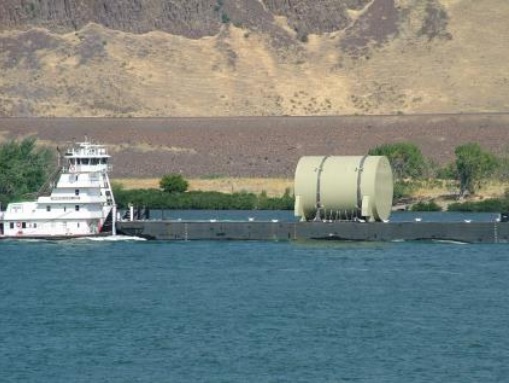The Oregon Department of Energy ensures the safe transport of decommissioned Naval reactor compartments through the state.
Decommissioned Naval Reactor Compartments at Hanford

Since 1986, the U.S. Navy has disposed of reactor compartments from deactivated
nuclear-powered warships at the
Hanford site in Washington state.
Oregon takes an
active interest in the program because the Navy ships the compartments 310 miles
up the Columbia River. Oregon's involvement is to ensure the safe transport of the
compartments.
The Navy has retired more than 110 nuclear-powered submarines and nine nuclear-powered
cruisers. These reductions in the nuclear fleet are the result of the
retirement of aging weapons systems and cutbacks in the number of U.S. Navy
ships in the post-Cold War era. The reactor compartments are prepared for disposal
at the Puget Sound Naval Shipyard and Intermediate Maintenance Facility in
Bremerton, Washington.
The Hanford site occupies 567 square miles of south-central Washington desert.
The reactor compartments are placed in a large open pit in the 200 East Area of
the
site, which is on a plateau about seven miles from the Columbia River.
Eventually, the pit will be covered with dirt.
The Naval compartments
are classified as low-level radioactive waste. They do not contain loose radioactivity
or contaminated fluids and their exteriors are not contaminated. The iron and
metal alloys within the reactor vessel have become radioactive after years of
reactor operations.
Before deciding on Hanford as its disposal site, the Navy considered other U.S.
Department of Energy sites, and considered disposing of the compartments by
sinking them in the ocean. After evaluating the costs and the environmental
impacts of both ocean disposal and land burial, the Navy determined that land
disposal at Hanford was the preferred option.
The Decommissioning Process
Naval reactor compartments are located in the middle of a submarine. The
compartments contain the reactor vessel, steam generators, pumps, valves, and
piping. The Navy removes the nuclear fuel from the reactor as part of the
deactivation process. Fluids are drained from the reactor systems and pipes are
sealed. The entire reactor compartment and some adjoining areas are then cut
from the remainder of the submarine and steel plating is welded on each end to
seal the compartment.
The submarine reactor compartments that have been taken to Hanford are about
33 feet high and 40 feet in length. They weigh between 1,130 and 1,680 tons.
Eventually, the Navy may deactivate its Ohio class submarines in the same manner.
Those compartments would be much larger and heavier.
The Navy's nuclear-powered cruisers have two reactor compartments each.
Deactivation is similar as with the submarines – spent fuel is removed, fluids are
drained, and pipes are sealed. The compartments are then cut from the ship and
sealed.
Safe Transport
The Navy must comply with U.S. Department of Transportation (USDOT) regulations
when shipping the reactor compartments. Radiation levels must meet USDOT limits.
The Navy performs radiation surveys of each reactor compartment before it leaves
for Hanford. The Washington Department of Health and Oregon’s Radiation
Protection Services survey most shipments as an independent verification. The
external radiation levels of the compartments are so low that they are not
detectable more than a few yards away.
The reactor compartments are welded on barges that have been modified to
increase their strength and stability. A flooding detection system alerts the tug
crews if the barge begins to take on water. If a barge should sink, transponders
automatically activate to allow response crews to locate the barge. A salvage buoy
also automatically deploys to mark the barge's position. Cables or slings attached to
the reactor compartment allow the compartment to be raised. The Navy and the
U.S. Coast Guard would handle salvage efforts.
The barges are towed by a commercial tug boat. A backup tug and a Navy or Coast
Guard escort vessel accompany each shipment. The barges use normal commercial
towing lanes. After traveling north through Puget Sound and south along the
Washington coast, the shipments enter the Columbia River and are guided across
the Columbia River bar by a licensed bar pilot.
River pilots guide the shipment during the entire trip along the Columbia River to
the Port of Benton in Richland, Washington. There, the reactor compartment is transferred
from the barge to a large trailer for the trip onto the Hanford site. The entire trip
usually takes about five days.
The Navy notifies the State of Oregon of each shipment. Shipments are made in the
spring or fall, when ocean and river conditions are acceptable. The State of Oregon
reviewed the Navy's plans for ensuring safe transport of the reactor compartments
before the first shipment was made. The state found that the Navy met or exceeded
all USDOT requirements.
During the mid-1990s, the Navy shipped as many as 11 compartments in a single year. Shipments now range between 0-2 per year.